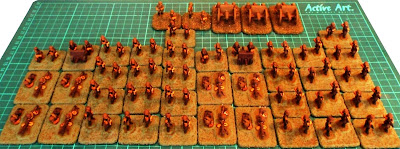Like most wargamers of my generation (i.e. those born during the late 1940s and early 1950s) I began my wargaming in the age of Donald Featherstone’s WAR GAMES and James Lawford’s and Peter Young’s CHARGE! I had armies of Airfix plastic figures and a collection of model vehicles manufactured by ROCO and Airfix, with air support supplied by model aircraft from Frog and Airfix. I had two main collections – American Civil War and World War II – and I fought numerous wargames with them on the floor of my shared bedroom and the living room floor and table. I eventually ended up with a green-painted pasting table … which was great for battles that could be fought on a tabletop that was approximately 2’ wide and 6’ long!
After leaving school in 1968 I bought my first metal figures from Hinton Hunt’s shop in Camden Passage. It was just after Tony Richardson’s film ‘The Charge of the Light Brigade’ was released, and I bought a number of British and Russian infantry and cavalry, which I painted (very badly) using gloss Humbrol enamel paints. (I still have some of them in storage and I really ought to strip of my awful paint job and repaint them.) I supplemented the Russian infantry with some bought from Douglas Miniatures, which were painted using Matt Humbrol enamel paints.
I studied for my Cambridge University Certificate in Education at Hockerill College of Education, Bishop’s Stortford, from 1971 to 1973, and during my time there I bought quite a few ROCO Cold War tanks and vehicles. Once I had qualified, I worked for two years at Burnt Mill Comprehensive School, Harlow, and my Cold War and World War II collections continued to expand. I did attend a few meetings of the Harlow Wargames Club, but never felt particularly welcome, and this confirmed my decision that solo wargaming was for me.
In 1975 I moved to London and began working at Woolwich Polytechnic School for Boys, Woolwich, and during my time there I was able to run an after-school wargame club which attracted a few loyal members, one of whom (Alan Abbey) I am still in regular contact with.
It was during the late 1970s that I came into contact with Eric Knowles, and for the first time I actually began to wargame as a member of a group (you could never term the collection of wargamers who met once a week in Eric’s shop’s basement as a club!) and took part in the Madasahatta Campaign … which fired my interest in colonial and World War I wargaming. In 1980 the late Paddy Griffith invited me to attend what became the first Conference of Wargamers (COW), and I’ve remained a very active member of Wargame Developments ever since, having served as the Treasurer and Membership Secretary for the last forty-three years.
By the mid 1980s I was married to Sue, and I had moved on to a new role as a Post-16 Consortium Coordinator. I was based in a number of schools in the Borough of Greenwich, and whilst I was at Thomas Tallis School, I ran a wargame option as part of their Wednesday afternoon elective studies course. It was quite a successful course (we fought an Eastern Front/Great Patriotic War mini-campaign) and I actually had one student achieve an A grade for his General Studies GCSE coursework based around a wargame that he designed.
When the Inner London Education Authority (ILEA) was wound up in 1991 I moved on to work as the Technical and Vocational Education Initiative (TVEI) coordinator and Head of Careers/Work Experience Coordinator at Crown Woods School, and I remained there as a full-time teacher until 2001. At that point my job became redundant, and I set up a teaching supply agency that provided experienced teaching staff to fill long term vacancies … and I returned to work in the IT Department at Crown Woods School for several days a week whilst also working part time for the Greenwich Education Business Partnership (GEBP). I finished my career in 2013 as a Business Studies and Travel & Tourism Lecturer at Crossways Sixth Form in Brockley, at which point I decided that forty years in teaching was enough and that it was time to retire.
During my working life I continued to wargame as and when I could and built up - and disposed of - quite a few collections. Now that I am a seventy-three-year-old, the time has come to think seriously about downsizing my collections, and recently I have been pondering the answer to the wargamer’s version of the final ‘Desert Island Discs’* question: what wargaming book and what wargame collection would you want to have with you if you were marooned on a desert island?
After considerable thought my reply would be:
- Joseph Morschauser’s HOW TO PLAY WARGAMES MINIATURE (which just bumped Donald Featherstone’s WAR GAMES into second place).
- My Eastern Front/Great Patriotic War collection (with my Belle Époque collection just behind it).
Writing this blog post and answering that question has helped me to identify how I now want to move forward for the foreseeable future.
* For the benefit of my non-UK blog readers, ‘Desert Island Discs’ is a BBC radio programme that has been broadcast weekly (with seasonal breaks) since 29th January 1942! The format is simple: each week a guest is invited to share a choice of the top ten records that they would like to have with them if they were castaway on a desert island. They were also entitled to chose one book (in addition to the Bible or similar religious book and the complete works of Shakespeare) and one luxury that they could take with them.












































.jpeg)
























